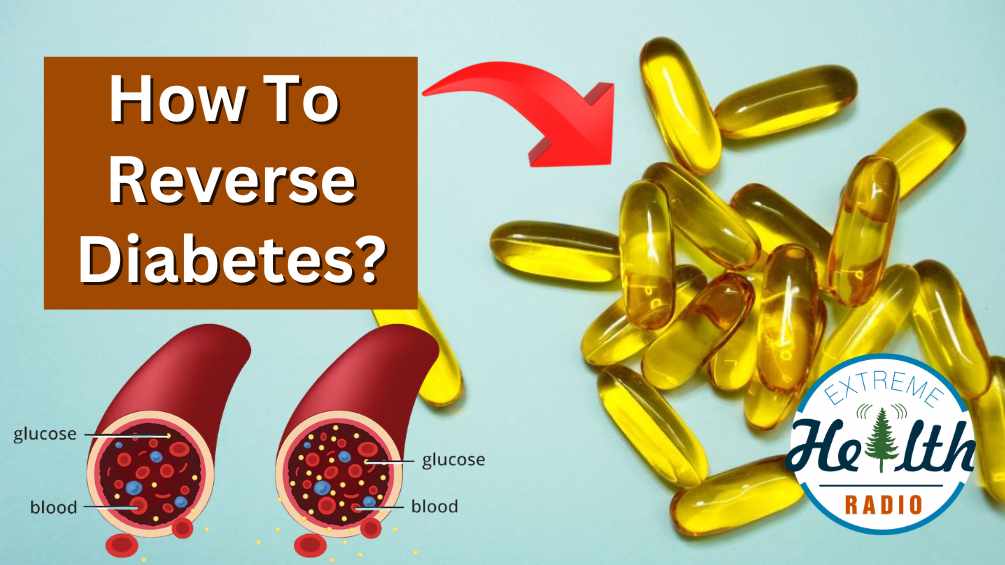
I get asked all the time about how to get rid of diabetes naturally. In this article I’m going to focus on Type 2 diabetes and not type 1. I’ll save that research for another article entirely.
But people always ask me about home remedies and natural cures for health conditions.
Diabetes isn’t something you can just “take a pill” for. It’s a systemic diet, lifestyle and environmental problem.
Diabetes and blood sugar is a really complex subject and it’s important to know what causes it, what symptoms to look for, what tests to get to confirm if you have it and so on.
But to answer the entire reason you’re reading this article right now about things you can do to treat this condition I’ll post my research below along with studies proving what I’m saying.
Before we dive in, I want to share with you good news, you can reverse diabetes naturally without drugs. It is possible and many thousands of people have done it.
Supplements:
Main Things To Avoid:
- Blue light
- nnEMF (wifi, cell towers, dirty electricity etc)
- PUFAs
- Time indoors
Diabetes Symptoms
We know that diabetes is linked to cancer, macular degeneration, a weakened immune system, heart disease, dementia and so much more.
It’s really important to manage your blood sugar levels throughout your life. If you do not, you are asking to be diagnosed with one of these diseases.
Here are some symptoms to look out for. Just note that just because you have some of these diseases doesn’t mean you have diabetes. And just because you have diabetes doesn’t mean you can’t get rid of it naturally with lifestyle and environmental changes.
This is not meant to scare you but empower you to know that you can change. Yes diabetes is a serious condition but it can be reversed but it requires discipline, self love, self respect and change.
With that said here are some symptoms to watch out for in your own body…
- Frequent urination (Polyuria)
- Excessive thirst (Polydipsia)
- Extreme hunger (Polyphagia)
- Unexplained weight loss
- Fatigue
- Blurred vision
- Slow-healing wounds
- Frequent infections
- Tingling or numbness in hands and feet
- Darkened skin patches (Acanthosis Nigricans, common in type 2 diabetes)
Diabetes Testing
If you suspect you may have diabetes you may want to get tested. I want you to know that before you test anything, it’s important to note that any biological health test is just a “snapshot” in time. This means that at the time of testing, your body did present indications of a particular condition.
Naming conditions is a trick the medical industrial complex does to map that name with a drug. I don’t even like saying “I have XYZ”. Because it’s just not true. You are not your body, so you can never “have a condition”. Your body may be showing signs of imbalance at a particular time, but that doesn’t mean you have the condition.
Also many blood tests, HTMA tests are not even accurate. The levels are skewed and most likely they’re looking in the wrong place coming to a wrong conclusion. Vitamin D (which is a secosteroid hormone) is a perfect example.
They test your blood, when it’s fat soluble vitamin and should be tested in your fat cells and liver. But they’ll test your blood and then tell you you’re deficient. There are 14 different types of 25OHD (the storage form of vitamin d) and they only test for one of those 14. And they should be testing 1,25 (active) but instead they’re testing storage.
So they’re looking at the wrong thing, in the wrong place and come to a million conclusions about that.
Vitamin D is just one example just about every biological test they do. It’s just something to be aware of. Don’t put all of your energy into testing.
I’m going to post a show we did about vitamin D below because it’s not what you think.
With that said a test if you think you have diabetes or it runs in your family and are concerned is the Kraft prediabetes test.
- Fasting Blood Sugar (FBS) Test
- Measures blood glucose after fasting for at least 8 hours.
- Normal: Below 100 mg/dL
- Prediabetes: 100-125 mg/dL
- Diabetes: 126 mg/dL or higher on two separate tests
- Oral Glucose Tolerance Test (OGTT)
- Measures blood glucose before and two hours after drinking a high-glucose beverage.
- Normal: Below 140 mg/dL
- Prediabetes: 140-199 mg/dL
- Diabetes: 200 mg/dL or higher
- Hemoglobin A1C (HbA1c) Test
- Reflects average blood sugar levels over the past 2-3 months.
- Normal: Below 5.7%
- Prediabetes: 5.7% – 6.4%
- Diabetes: 6.5% or higher
- Random Blood Sugar (RBS) Test
- Measures blood glucose at any time of the day, regardless of fasting.
- A result of 200 mg/dL or higher, along with diabetes symptoms, suggests diabetes.
- Continuous Glucose Monitoring (CGM)
- A wearable device that tracks glucose levels in real-time, mainly used for patients already diagnosed with diabetes.
Where to Get Diabetes Tests Done
- Hospitals and Clinics – Most general hospitals and primary care clinics offer diabetes tests.
- Pharmacies – Many pharmacies offer quick glucose screenings.
- Diagnostic Laboratories – Private labs like Quest Diagnostics and LabCorp provide comprehensive diabetes testing.
- At-Home Test Kits – Available for FBS, HbA1c, and CGM, allowing monitoring from home.
Causes of Diabetes
Obviously most of you reading this will think eating too much sugar is going to cause diabetes and that is correct. But I want to share with you a few other causative factors that in my opinion, play just as big of a role in developing diabetes as eating sugary processed foods.
One of those is blue light (how to fix) and the other is PUFAs (Btw the antidote to PUFAs is Vitamin E). There is mounting evidence in the scientific literature saying how excess blue light and a lack of sunlight directly links to diabetic conditions. In fact did you know that artificial light at night (ALAN) while you sleep can cause blood sugar spikes?
You may be wondering about how blue light does this. Well it does it in two primary ways. One is that blue light depletes melatonin which helps regulate blood sugar. Less melatonin means more reaction to sugar.
The other way blue light does this is through ROS (reactive oxygen species) and inflammation. The blue wavelength of light his very high frequency and causes oxidative stress to every cell in your body. More oxidative stress means more disease, including diabetes. There are many studies showing this.
The other trigger for diabetes is the consumption of Omega 3 fatty acids as PUFAs (polyunsaturated fatty acids). These fats oxidize immediately inside the human body.
“But my fish oil is nitrogen flushed, pristine and cold processed!” you say.
That’s great but what happens when you put a highly unstable lipid with weak hydrogen bonds inside a body that’s filled with light, heat and oxygen? They oxidize.
The environment (your body) you’re adding the pristine fish oil into, is one that causes oxidation of unstable fats.
What did we learn about blue light and oxidation?
The more oxidative stress you have the more susceptible to diabetes you are.
Of course there are other causes of diabetes too like fluoride, lack of sleep, heavy metals like iron, parasites and more.
Aside from what I mentioned above here are some other risk factors and potential causes of diabetes that are worth noting.
Exhaustive List of Diabetes Causes
1. Genetic Factors
- Family history of diabetes increases the risk.
- Specific genes related to insulin production and glucose metabolism.
- Autoimmune reactions causing Type 1 diabetes (e.g., destruction of pancreatic beta cells).
2. Lifestyle and Dietary Factors
- Obesity: Strongly linked to insulin resistance and Type 2 diabetes.
- Sedentary lifestyle: Physical inactivity reduces insulin sensitivity.
- Unhealthy diet:
- High intake of sugar-sweetened beverages.
- Excess consumption of non organic processed meats.
- High intake of refined carbohydrates and low fiber diet.
- Skipping breakfast and irregular meal patterns.
- High-heat cooking methods: Formation of advanced glycation end products (AGEs), increasing insulin resistance.
3. Environmental Factors
- Persistent Organic Pollutants (POPs): Pesticides and industrial chemicals can increase insulin resistance.
- Bisphenol A (BPA) exposure: Found in plastics and linked to insulin resistance.
- Heavy metals and toxins: Lead, arsenic, and mercury have been linked to diabetes risk.
- Air pollution: Some studies suggest exposure to pollution may contribute to insulin resistance.
4. Metabolic and Hormonal Factors
- Insulin resistance: The body’s inability to use insulin effectively, leading to Type 2 diabetes.
- Metabolic syndrome: A cluster of conditions including high blood sugar, high blood pressure, and abnormal cholesterol levels.
- Hormonal imbalances: Such as those seen in polycystic ovary syndrome (PCOS).
5. Medical Conditions and Medications
- Pancreatic diseases: Conditions like pancreatitis and pancreatic cancer can impair insulin production.
- Vitamin and mineral deficiencies
- Low vitamin D levels may contribute to insulin resistance.
- High iron levels can increase diabetes risk.
- Certain medications:
- Corticosteroids and some antipsychotics can increase diabetes risk.
- Some blood pressure medications may impact glucose metabolism.
6. Autoimmune and Gut-Related Factors
- Type 1 diabetes: Triggered by an autoimmune response that destroys pancreatic beta cells.
- Cow’s milk and gluten: Some studies suggest a link between early exposure to cow’s milk proteins and Type 1 diabetes.
- Gut microbiome imbalance: Alterations in gut bacteria can influence metabolism and glucose regulation.
7. Other Contributing Factors
- Age: Risk increases with age, particularly after 45.
- Ethnicity: Certain groups (e.g., African Americans, Hispanics, Native Americans, and Asians) have a higher genetic predisposition.
- Stress and sleep deprivation: Chronic stress and poor sleep quality can lead to insulin resistance.
Home Remedies For Diabetes
In my last article I highlighted 6 supplements to lower blood sugar naturally. I also included 6 more as a bonus because there are many things you can do at home to lower your blood sugar. The first thing you want to do is to stop participating int the things that are causing diabetes.
These would be…
- Blue light
- Lack of sunshine
- Polyunsaturated fatty acid intake
- Lack of exercise
- Excess EMF exposure
- Sleep deprivation
- Fluoride
- Chemical and heavy metal exposure
To really understand the big one here (which is light) I would highly suggest you follow everything in my Biohacking Light Protocol. Avoiding seed oils, fish oils and vegetable oils is pretty simple. Getting sun is easy. Just make sure you’re not wearing sunglasses or sunscreen and that will help to regulate melatonin levels and set your daily circadian rhythms.
If you’re having issues with sleep, then you also have issues with blue light and nnEMF.
Exercise is easy, just do it outside and not under fluorescent lighting in a gym. I don’t recommend that at all. If you have to do it inside, open the windows. If you’re stuck at a gym, make sure you wear your yellow blue blocking glasses if it’s daytime (I don’t recommend working out after sunset) or your orange blue blocking glasses if it’s after sunset.
Now that you’re living a more healthy nature based lifestyle here are some supplements you can add to your daily health routine if you have diabetes.
Here are some home remedies for diabetes that research shows, work.
1. Cinnamon
- Effect: May improve glycemic control by increasing glucose uptake.
- Dosage: 1–3 grams per day for 4 to 18 weeks.
- Source: A meta-analysis concluded that cinnamon consumption is associated with a statistically significant decrease in levels of fasting plasma glucose. (PMID: 24019277)
2. High-Fiber Diet
- Effect: Reduces fasting blood glucose and improves insulin sensitivity.
- Sources: Whole grains, legumes, vegetables, and low-glycemic fruits.
- Source: A systematic review indicated that increased dietary fiber intake is associated with improved glycemic control in Type 2 diabetes patients. (PMID: 20713332)
3. Berberine
- Effect: Comparable to metformin in lowering blood sugar levels and improving insulin sensitivity.
- Dosage: 500 mg three times daily.
- Source: Clinical studies have shown that berberine significantly lowers fasting blood glucose and HbA1c levels. (PMID: 36467075)
4. Magnesium
- Effect: Helps improve insulin sensitivity and glucose metabolism.
- Dosage: 300–500 mg per day.
- Source: Studies indicate that magnesium supplementation improves insulin resistance and lowers fasting glucose levels. (PMID: 30587761)
5. Vitamin C
- Effect: Reduces oxidative stress and helps control blood glucose.
- Dosage: 500–1,000 mg/day.
- Source: Vitamin C supplementation may improve glycemic control and blood pressure in people with Type 2 diabetes. (PMID: 36526243)
6. Vitamin E
- Effect: Reduces oxidative stress and helps control blood glucose.
- Dosage: 400–800 IU/day.
- Source: Vitamin E intake has a beneficial role in improving HbA1c and insulin resistance in individuals with diabetes. (PMID: 36800965)
7. Avoiding High-Heat Cooking Methods
- Effect: Reduces advanced glycation end products (AGEs), which contribute to insulin resistance.
- Source: Research indicates that dietary intake of AGEs is linked to insulin resistance and diabetes complications. (PMID: 37443718)
8. Chromium
- Effect: Enhances insulin action and reduces blood sugar levels.
- Dosage: 200–1,000 mcg/day.
- Source: Chromium supplementation has been found to improve glucose metabolism in individuals with Type 2 diabetes. (PMID: 20425574)
- Effect: Reduces oxidative stress and helps with diabetic neuropathy.
- Dosage: 600–1,200 mg/day.
- Source: Clinical trials have demonstrated that ALA supplementation improves symptoms of diabetic neuropathy. (PMID: 25535146)
Conclusion
One main point I want to impart on you is that you cannot live the same way that you used to, while taking some supplements and hope that your diabetes magically goes away. You can take all the supplements and all the home remedies you want, but if you’re sitting in front of a blue lit screen all day and still eating processed junk food, nothing is going to change.
Before adding supplements I would fix your light environment, habits, nnEMF exposure, outdoor time, workout schedule and diet before adding supplements. Ideally you would do all of these things at the same time.
If you did all of what I’m describing in this article for 30 days in a row you would most likely have extremely dramatic results!
Better yet, make it lifestyle….because you are worth it.
Questions:
- Does diabetes run in your family?
- What are your symptoms?
- If you deal with blood sugar spikes, what works best for you?
Comment below!


